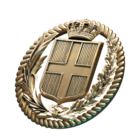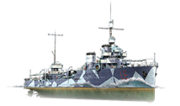Italian Destroyer Collection
Between World War I and II, the Italian Navy (Regia Marina) was the third-largest in Europe. In terms of surface craft, key attention was paid to building light forces - cruisers and destroyers. By the beginning of the 1940s, Italy's forces outnumbered those of the Anglo-French in the Mediterranean in terms of destroyers and torpedo boats. During World War II, Italian Navy destroyers discharged their duty honorably - Italy lost 58 destroyers out of a total of 71.
Our new collection will acquaint you with the artillery armament of the Regia Marina's destroyers and the decorations that Italian sailors were awarded with.
The overall collection is comprised of three sub-collections of six items, totalling 18 items. Items may be bought for 4 duplicates.
Contents
Collections
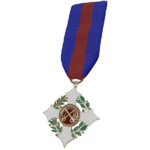
The Military Order of Savoy (in Italian: Ordine militare di Savoia) was established in 1815 by the King of Sardinia. Following the unification of Italy in 1861, the Order was included in the Kingdom's award system as the highest military award. In 1947, it was renamed to the "Military Order of Italy."
The Order has five different grades of merit conferred on service members in ascending rank as follows: the Knight grade can be bestowed upon any military servant; the Officer grade can be assigned to a military servant in the rank of an officer; and the Commander grade can be conferred on generals and admirals, who can further be promoted to the Grand Officer and Knight Grand Cross grades. The Order can be issued to individual personnel and entire military units.
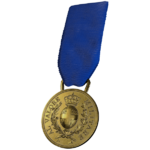
Established in 1833, the Gold Medal of Military Valor (in Italian: Medaglia d'oro al valor militare) is awarded to military personnel and even entire units for individual deeds of gallantry in action. Unlike the Military Order, it has no rank-related restrictions and is bestowed upon any soldier who has demonstrated outstanding courage and selflessness.
The Medal has three grades that are struck in gold, silver, and bronze, respectively. Military tradition dictates that senior-ranking service members are the first to salute to Gold Medal awardees, regardless of rank. In 1942, the Italian Navy ordered 20 destroyers of the new type, all named after warship commanders who had been awarded the Gold Medal posthumously for heroic actions.
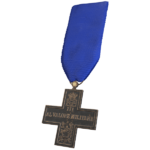
Established in 1922, the War Cross of Military Valor (in Italian: Croce di guerra al valor militare) is awarded for military valor in a time of war if an act of valor does not warrant the Bronze Medal of Military Valor.
The inscription it bears has changed several times. Until 1941, it matched that of the War Merit Cross, which has a lower precedence in the system of military awards. Until 1943, both decorations shared a similar ribbon. The only difference was that the War Cross of Military Valor had a clasp on the ribbon in the form of a horizontally placed Gladius sword sheathed with leaves.
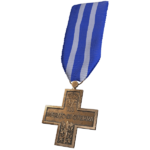
The War Merit Cross (in Italian: Croce al merito di guerra) was established in 1918 and was awarded for active service: 5 months in contact with the enemy, being wounded in action, and so on. Those serving in the navy had to spend at least 100 days at sea during their time in service.
Servicemen could be presented with this award several times, denoted by various combinations of miniature royal crowns of gold, silver, or bronze attached to the ribbon. Interestingly, the Cross used to be awarded no more than once a year and no more than three times during an entire war, even if the awardee had spent more than 36 months in the area of combat operations.
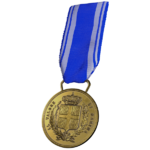
The Navy Medal of Heroism (in Italian: Medaglia al valore di Marina) has occupied its rightful place in the Italian system of military decorations since 1836, although its status has changed numerous times ever since. Under a decree dated 1938, the medal had three grades and was accordingly struck in gold, silver, and bronze.
It was intended to reward sailors - military and civilian - for displaying courage and exceptional nautical navigation skills in times of peace. The senior grades were awarded if a distinguished awardee had put their own life at risk while at sea.
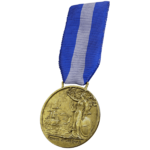
The Medal of Honor for Long Navigation (in Italian: Medaglia d'onore per lunga navigazione compiuta) was established in 1905 and was awarded to military and civilian sailors for years of service at sea.
Initially, it was awarded for 24 years at sea, but the medal later received three grades - gold, silver, and bronze - awarded for 20, 15, and 10 years of service at sea on ships and vessels, respectively. As they were awarded, the senior grades replaced the junior ones in line with the length of service.
Reward
Completing this sub-collection provides the following rewards:
| Icon | Name |
|---|---|
 |
Second flag for Italian destroyers |
Italian Destroyers: The Main Battery
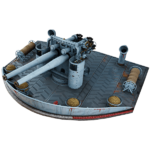
In 1914, the Royal Navy adopted the 102 mm QF Mk XV gun for its warships. That gun significantly outperformed the previously used same-caliber artillery systems in terms of its rate of fire. With the entry of Italy into World War I, the country launched its production under license. This gun was used for the main batteries of all Italian destroyers laid down between 1915 and 1917.
In 1920, the Italian Navy launched the construction of four Curtatone-class destroyers in an attempt to base this project on the experience gained in the past war. For the first time among all navies in Europe, the Italian 102 mm/45 Model 1919 guns were placed in twin-gun mounts.
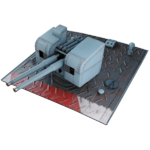
From 1921, new Italian destroyers and flotilla leaders were equipped with 120 mm main battery guns instead of the 102 mm ones. The first ones were three Leone-class flotilla leaders and two Sella-class destroyers designed on the basis of the Curtatone-class ships. They were followed by four Sauro-class destroyers laid down in 1924 and eight Turbine-class destroyers laid down a year later.
The Sauro-class ships received two twin-gun Vickers Terni Mod. 1924 mounts. Ships of the Turbine class received the same number of OTO Mod. 1926 mounts, which essentially differed by the manufacturing firm only. The 120 mm gun with a 45-caliber barrel could fire a 22 kg HE shell over a distance of 15.5 km at a speed of 850 m/s.
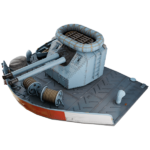
The shift to a new model of 120 mm guns with a 50-caliber barrel happened on a series of 12 flotilla leaders named in honor of Italian navigators (the Navigatori class). They were laid down in 1927 as a counter-response to the new French flotilla leaders of the Jaguar and Guépard classes. Due to a higher rate of fire, Navigatori, equipped with three twin-gun mounts, outmatched the preceding Leone class that had four mounts of the old design.
Two such mounts were placed on each of the four Dardo-class and four Folgore-class destroyers designed on the basis of the Turbine class and laid down between 1929 and 1930.
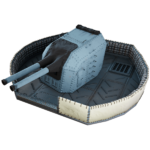
Dardo- and Folgore-class destroyers were created for joint operations with Zara-class cruisers. Therefore, higher requirements were placed on them in terms of speed and cruising range. But the projects were not particularly successful, especially in terms of their seaworthiness.
The main shortcomings were rectified in the next series of four Maestrale-class destroyers laid down in 1931. The ships received two twin-gun mounts produced by OTO as their main batteries. The mounts were a 2.5-ton-lighter modification of the 120 mm/50 Ansaldo Mod. 1926 mounts used on their predecessors.
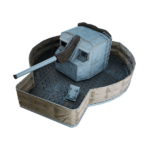
Seventeen Soldati-class ships turned out to be the most successful and numerous class of Italian destroyers. Their artillery comprised two twin-gun 120 mm/50 Ansaldo Mod. 1936 or 1937 mounts and a very controversial artillery system - a special 120 mm/15 howitzer for illumination projectiles. It was replaced on Carabiniere - a first-series destroyer commissioned in 1938 - with a fifth 120 mm/50 gun.
Four ships of the second series, laid down in 1940, received the same gun, and four more destroyers from the first series were rearmed in 1941 and 1942.
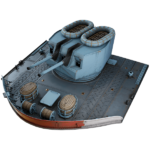
The Attilio Regolo warship of the Capitani Romani class ranked as one of the ocean-going scouts (in Italian: esploratori oceanici) - fast ships with good seaworthiness and guns so powerful that the ships would later be reclassified as light cruisers. As a result, only four ships of the Capitani Romani class were built out of the twelve laid down in 1939.
Four twin-gun mounts onboard these flotilla leaders housed the same 135 mm/45 guns that made up the secondary batteries of the Andrea Doria-class battleships, placed in triple-gun turrets. The single-gun mounts with shields were supposed to be placed on the unfinished Comandanti Medaglie d'Oro-class destroyers and aircraft carrier Aquila.
Reward
Completing this sub-collection provides the following rewards:
| Icon | Name |
|---|---|
 |
Second flag for Italian cruisers |
Italian Destroyers: AA Defenses
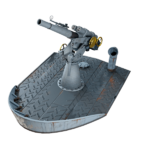
Because Italy entered World War I almost a year after it broke out, the Regia Marina had time to draw on the experience of other countries. One of the key lessons learned was the obvious necessity to equip warships with air defense systems.
Destroyers began to be equipped with licensed British 76 mm guns converted by the Ansaldo firm into anti-aircraft guns. Even the four Palestro-class destroyers and four Curtatone-class destroyers that entered service in the early 1920s each received two 76 mm/30 Armstrong mounts that were replaced by anti-aircraft machine guns only at the beginning of World War II.
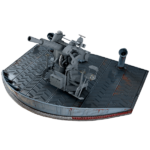
During World War I, Italy acquired a license from Great Britain to produce water-cooled two-pounder (40 mm) Mark II guns (known as "pom-poms" - a name that came from the sound the original models made when firing). In Italy, the AA gun was manufactured by Terni right up until the early 1930s.
The rate of fire was 50-75 rounds per minute, and the guns were belt-fed from a 50-round belt. Each round weighed 900 grams and self-destructed at a distance of about 4.5 km. All Italian destroyers commissioned between 1916 and 1934 received a pair of such machine guns. Only at the outbreak of World War II were they replaced with more modern anti-aircraft guns.
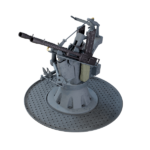
Initially, Italian destroyers relied on British-made Lewis light machine guns to cover their short-range air defense needs. In 1929, Breda (Italy) acquired a license for the production of the French 13.2 mm Hotchkiss machine gun. Under the "Model 1931" index, it was mounted on all destroyers of the Italian Navy that entered service between the late 1920s and the late 1930s.
As a rule, two twin mounts were used, but Soldati-class destroyers featured four twin and four single mounts. During World War II, machine guns were gradually driven out by small-caliber AA automatic guns.
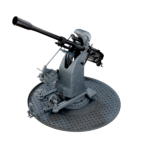
Twin mounts of these anti-aircraft guns were designed for use on battleships and cruisers to provide air defense at short-range. But during World War II campaigns, it didn't take long to realize how direly insufficient the then-existing AA defenses on board the light forces of the Italian Navy were against threats from the air.
From 1942, every effort was made to place the 37 mm machine guns in successful single mounts on the surviving destroyers of all suitable classes - from Turbine to Soldati. For that purpose, a torpedo launcher would be removed and replaced with a pair of AA guns. Capitani Romani-class ocean-going scouts initially came equipped with as many as eight such automatic guns.
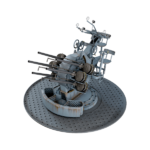
During World War II, twin and single 20 mm/65 AA automatic gun mounts from Breda and 20 mm/70 from Scotti constituted the backbone of the air defense capabilities of the Italian Navy's light forces. But destroyers began to be equipped with these AA guns at the start of the war only, at a time when countering threats from the air already required more powerful AA weapons and multi-gun AA systems with greater firepower.
In 1941, Breda proposed that a dual-purpose 20 mm automatic gun be used as both an aircraft cannon and an anti-aircraft gun. The six-gun mount could fire up to 3,600 shots per minute. But it never, in fact, made it past the prototype stage.
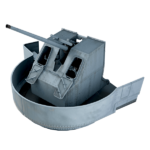
An up-to-date mid-range AA gun for the needs of the Italian Navy had to be designed when World War II had already broken out. The 65 mm guns were also supposed to be mounted on the Capitani Romani-class ocean-going scouts being built.
But by the time Attilio Regolo and two other same-type ships were ready (1942 and 1943, respectively), only test samples of the gun existed, which is why the Capitani Romani-class ships were eventually armed with the tried-and-tested 37 mm automatic guns. The automated, electronically driven gun feeding system could not be completed, the development of the gun mount began to drag, and it was finally discontinued with the capitulation of Italy in 1943.
Reward
Completing this sub-collection provides the following rewards:
| Icon | Name |
|---|---|
 |
Second flag for Italian battleships |
Overall Rewards
Completing the entire collection provides the following rewards:
| Icon | Name |
|---|---|
 |
Italian Cruisers: Part 2 The Savoy dynasty is one of the oldest in Europe. Its representatives ruled the duchy, then the Kingdom of Sardinia, and from 1861 to 1946-united Italy. The center of the coat of arms and flag of the Italian kingdom depicted a shield with a cross - the coat of arms and flag of the Duchy of Savoy. |
| Icon | Name |
|---|---|
| Leone Tier VI Premium Italian Destroyer |
| Icon | Name |
|---|---|
| |
Commander (3 Points) |
